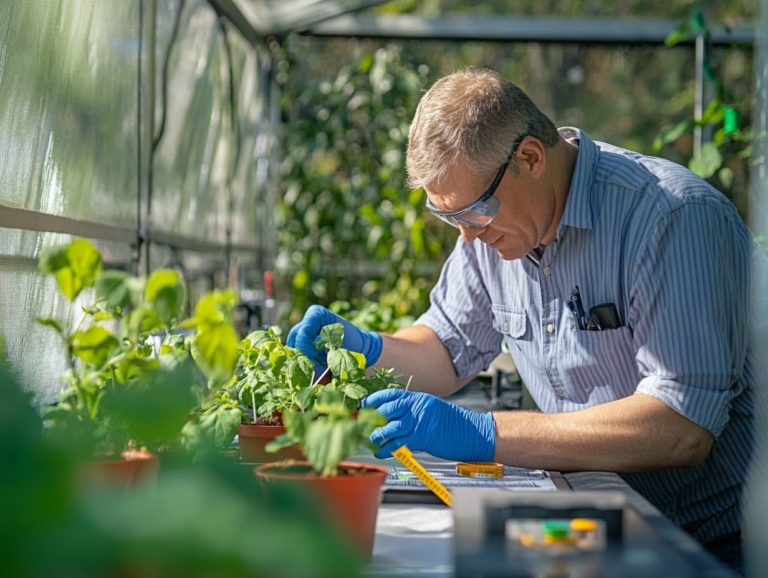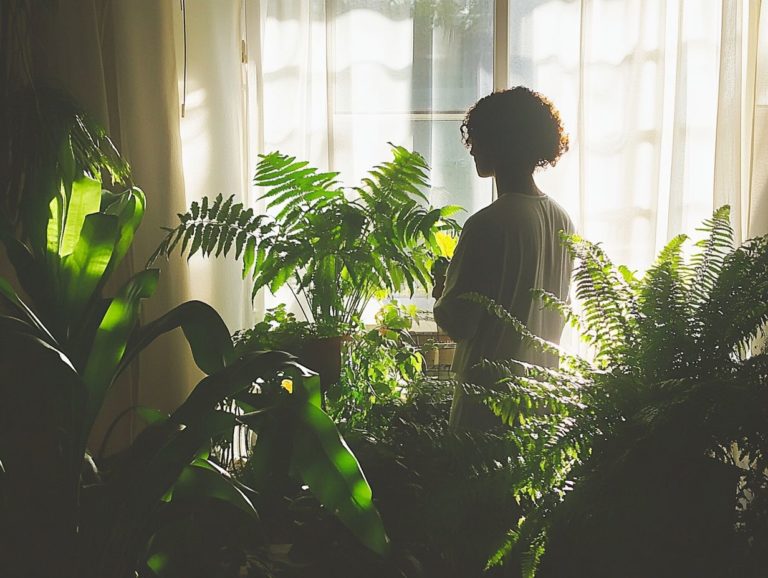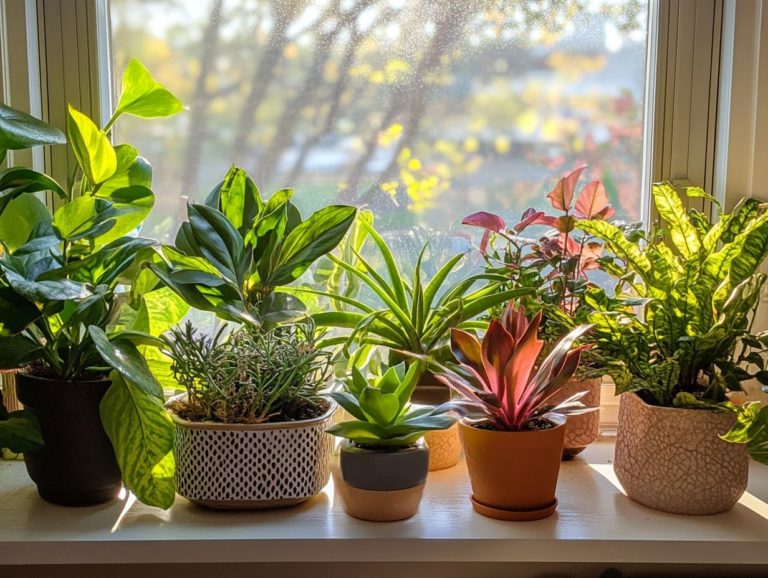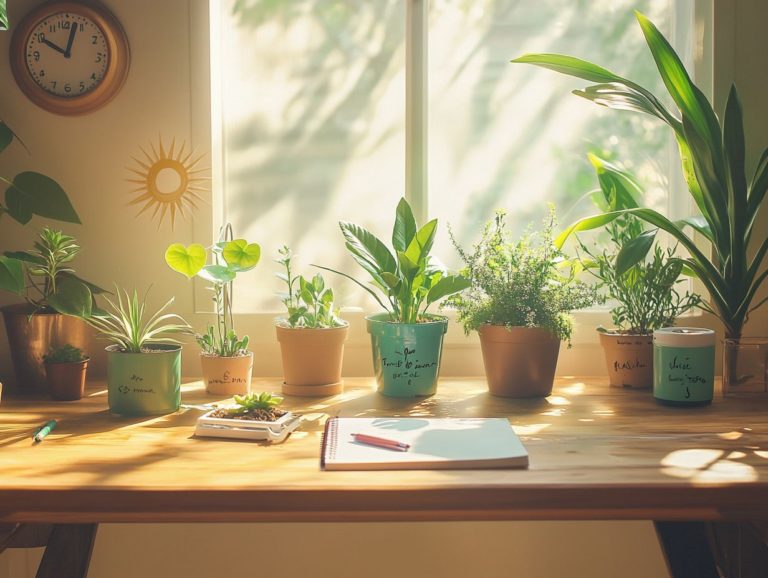Best Indoor Plants for North-Facing Windows
Finding the perfect indoor plants for your north-facing windows can feel daunting, but it doesn t have to be. These spaces typically receive less sunlight, so it s crucial to select hardy, low-light-loving varieties that can thrive in such conditions, especially tropical plants well-suited for these environments.
This article highlights 15 of the best indoor plants that not only flourish in these dimmer areas but also bring beauty and freshness to your home. Whether you’re a seasoned plant parent or just starting out, these options will inspire you to transform your space into a lush retreat.
Contents
- Key Takeaways:
- 1. Snake Plant
- 2. Pothos
- 3. ZZ Plant
- 4. Peace Lily
- 5. Spider Plant
- 6. Chinese Evergreen
- 7. Dracaena
- 8. Philodendron
- 9. English Ivy
- 10. Cast Iron Plant
- 11. Heart-Leaf Philodendron
- 12. Aloe Vera
- 13. Rubber Plant
- 14. Boston Fern
- 15. Dieffenbachia
- Frequently Asked Questions
- Do all indoor plants do well in north-facing windows?
- Can I place any type of houseplant in a north-facing window?
- Are there any benefits to having indoor plants in north-facing windows?
- Do I need to rotate my plants in north-facing windows to ensure even growth?
Key Takeaways:
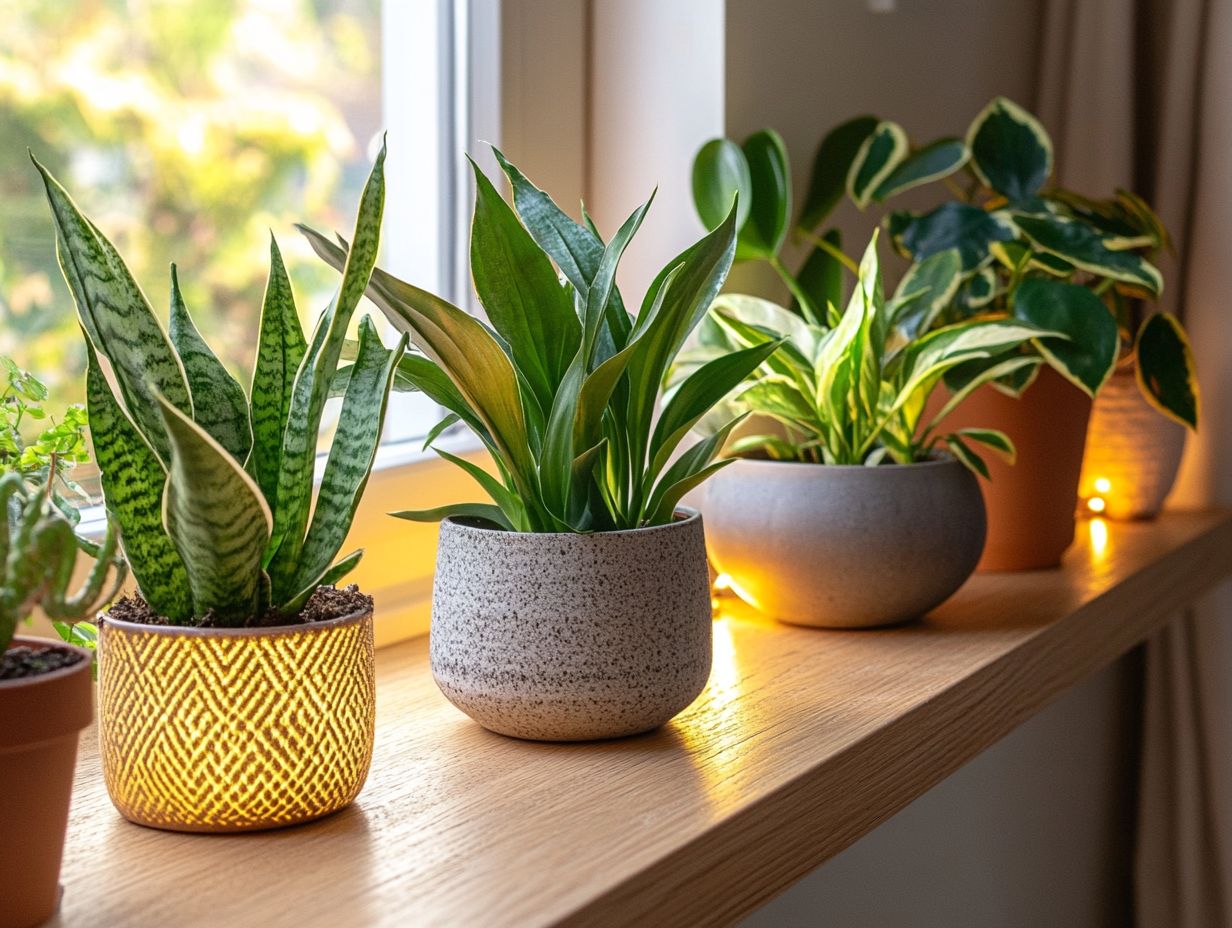
- Snake Plant: Low maintenance and perfect for beginners, this plant thrives in low light and can improve air quality.
- Pothos: Ideal for hanging baskets, this trailing plant does well in low light and helps purify the air.
- ZZ Plant: With its glossy, dark green leaves, this plant tolerates low light and requires minimal care.
1. Snake Plant
The Snake Plant, or Sansevieria Black Coral, is a resilient choice for anyone looking to elevate their indoor spaces, especially in homes with north-facing windows that only provide indirect light. This low-maintenance tropical marvel thrives in low-light conditions and purifies the air, making it an ideal addition for those who appreciate both aesthetics and health benefits.
Its adaptability to various humidity levels allows it to flourish in environments ranging from dry to moderately humid. Maintain temperatures between 60 F and 80 F to keep it comfortable in different rooms of your home.
Water your plant regularly, allowing the soil to dry out between sessions. This is perfect for those with busy lifestyles. With minimal effort, the Snake Plant enhances your decor and contributes to a healthier living space by filtering toxins from the air, seamlessly merging functionality with beauty.
2. Pothos
Pothos is a remarkably versatile and low-maintenance tropical plant that effortlessly adapts to various lighting conditions, including indirect light. This quality makes it an ideal choice for both novice and seasoned plant enthusiasts alike.
To keep your Pothos thriving, water your plant regularly. Allow the top inch of soil to dry out between sessions to prevent overwatering, which can lead to root rot, a condition when roots decay due to too much water. While Pothos flourishes in bright, indirect light, it can tolerate lower light conditions, making it a perfect fit for any corner of your home.
Beyond its aesthetic appeal, this hardy plant offers impressive air-purifying properties. It effectively filters out harmful toxins, enhancing overall air quality and creating a healthier indoor environment for you to enjoy.
3. ZZ Plant
The ZZ Plant, or Zamioculcas zamiifolia, is a superb choice for anyone seeking a striking yet low-maintenance tropical gem. It thrives effortlessly in low light and indirect light conditions, making it the perfect addition to brighten your space!
This remarkable houseplant demonstrates impressive resilience, making it ideal for those challenging corners of your home, like north-facing windows, where sunlight is rare. Its ability to store water in its thick, fleshy roots allows it to withstand neglect, requiring only minimal watering. For those interested in more options, consider Indoor Plants That Thrive in Low Light. Even in less-than-ideal environments, it retains its lush green foliage, infusing elegance into any living space.
For those with busy lifestyles, the ZZ Plant presents a perfect solution, flourishing beautifully without constant care.
4. Peace Lily
The Peace Lily, or Spathiphyllum, is a beautiful tropical plant. It thrives in indirect light, making it ideal for homes with north-facing windows.
This plant is not just attractive; it purifies the air and is safe for pets. To keep your Peace Lily lush and blooming, ensure humidity levels are around 40-60%.
Places like the bathroom or kitchen are great spots, or you can mist its leaves regularly.
Water it when the top inch of soil dries out to avoid overwatering. The Peace Lily helps eliminate common indoor toxins like formaldehyde and benzene. This creates a healthier environment and boosts your overall well-being.
5. Spider Plant
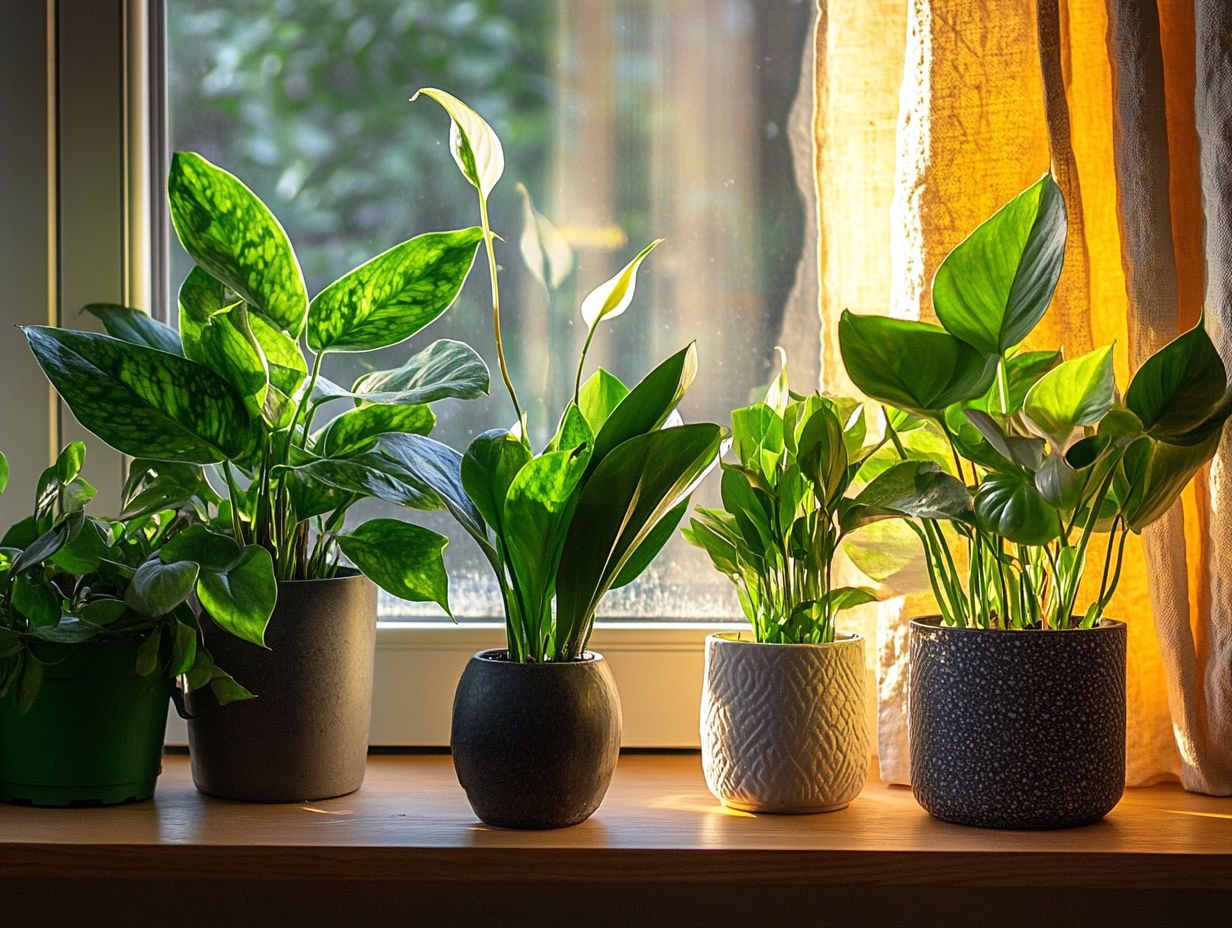
The Spider Plant is a timeless, low-maintenance tropical gem. It thrives in indirect light, making it an excellent choice if you’re seeking an easy-care option that offers air-purifying advantages.
This resilient plant prefers soil that allows excess water to escape easily and flourishes with moderate watering. Just let the top inch of soil dry out before watering again.
Generally, watering once a week or every two weeks works well. Keep an eye on its leaves; browning tips may mean it needs more hydration.
Spider Plants appreciate a slightly humid environment, so a bit of misting can work wonders. Their impressive ability to filter toxins from the air enhances your indoor space and boosts air quality.
6. Chinese Evergreen
The Chinese Evergreen is a remarkably forgiving tropical plant. It thrives in low and indirect light, making it a top choice for anyone who might struggle with more temperamental varieties, especially in north-facing windows.
This adaptability allows it to flourish in various indoor settings, whether in a cozy office or a dimly lit corner of your home.
With an array of captivating varieties featuring unique leaf patterns and colors, you re sure to find one that perfectly matches your aesthetic preferences.
Caring for these plants is simple; they enjoy infrequent watering and well-draining soil to prevent root rot. Their resilience makes them perfect for both novice and experienced plant lovers.
7. Dracaena
Dracaena offers a stunning variety of species that flourish in low-maintenance conditions. They are perfect for plant parents eager to enhance spaces with north-facing windows that provide only indirect light.
Among these resilient varieties, you’ll find Dracaena marginata, known for its slender, arching leaves, and the impressive Dracaena fragrans, often called the corn plant, which can grow to remarkable heights.
Water moderately, allowing the top few inches of soil to dry out between sessions. While they generally prefer bright, indirect light, they adapt well to lower light levels.
Their versatility allows these plants to blend effortlessly into various home environments, whether your style is minimalist contemporary or cozy bohemian.
8. Philodendron
Philodendron species are truly a favorite among plant enthusiasts, thanks to their remarkable ability to adapt to low and indirect light. They re the ideal choice for those seeking to infuse lush greenery into spaces with north-facing windows.
Beyond their impressive resilience, these plants offer an extraordinary variety of shapes, sizes, and colors that can transform any interior decor into a vibrant haven. Take the heartleaf Philodendron, for instance; its heart-shaped leaves cascade beautifully and add a charming touch.
Meanwhile, the monstera flaunts striking splits and holes that inject a dramatic flair into your home environment.
Caring for these plants is easy. A simple routine of watering when the top inch of soil is dry, paired with just a little spraying with water now and then, can foster lush growth without demanding much from you.
Not only do they elevate your space aesthetically, but they also play a vital role in purifying indoor air, creating a healthier atmosphere for everyone who shares it.
9. English Ivy
English Ivy is an exceptional climbing plant that not only elevates your indoor decor but also boasts impressive air-purifying qualities. It’s an ideal choice for those seeking a tropical touch that thrives in indirect light.
To grow this great plant inside, you’ll want to ensure it receives just the right amount of water allow the soil to dry out slightly between waterings to keep root rot at bay.
Regular trimming helps it grow better and promotes a bushier appearance while letting you remove any yellowing leaves that could detract from its overall charm.
Placing English Ivy near windows strikes the perfect balance of light it craves. Its remarkable ability to filter toxins like formaldehyde and benzene makes it a wise addition to your home.
This plant is a real treat for your eyes; it s a savvy choice for enhancing your indoor air quality as well, making it a fantastic addition to any collection of tropical plants. Don’t miss out on the chance to add the stunning English Ivy to your collection!
10. Cast Iron Plant
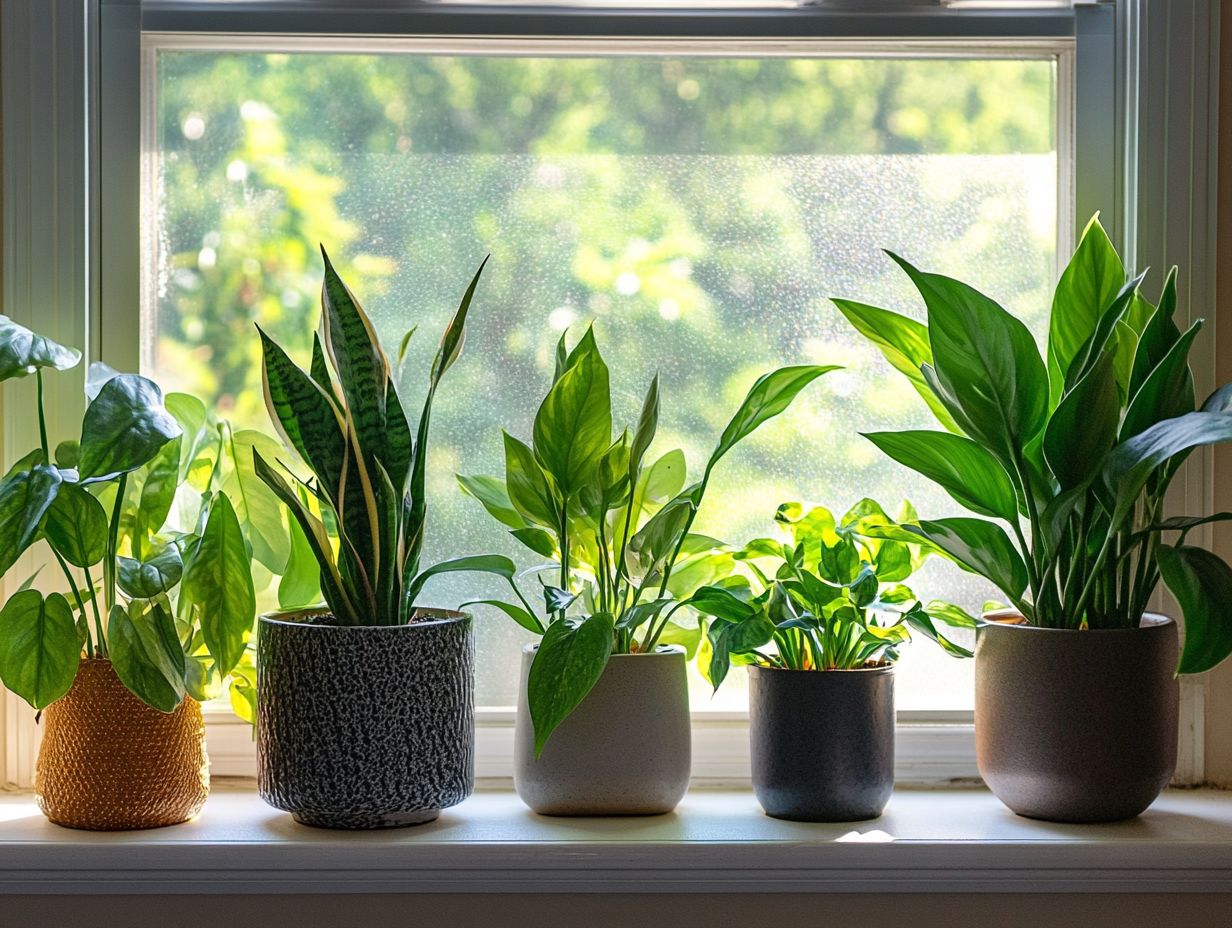
The Cast Iron Plant, known scientifically as Aspidistra elatior, is your go-to for a robust and resilient greenery option. It thrives in low light, making it an excellent choice for those north-facing windows where other plants might shy away.
With its impressive ability to endure neglect think infrequent watering and temperature swings it s a reliable companion, especially for novice gardeners who might still be finding their footing.
This plant adapts beautifully to various settings, whether you’re gracing a cozy apartment or a bustling commercial space with its presence.
The Cast Iron Plant s dark green, glossy leaves bring a touch of elegance to your space, effortlessly handling occasional dust and humidity levels fluctuations. It s the perfect solution for anyone wanting to embrace greenery without the hassle.
Ultimately, it stands out as a versatile option, seamlessly integrating into any indoor environment while demanding minimal attention from you.
11. Heart-Leaf Philodendron
The Heart-Leaf Philodendron is a delightful tropical plant that thrives in indirect light, making it a perfect choice for those looking to infuse a bit of greenery into north-facing windows.
To ensure this beauty flourishes, maintaining optimal humidity levels is key aim for around 40-60%. Regular misting or placing a humidifier nearby can work wonders in achieving this ideal environment.
In terms of watering schedule, it s wise to let the top inch of soil dry out between watering sessions. This practice helps prevent over-saturation, which can lead to root rot.
Striking the right balance of moisture will keep those vibrant, heart-shaped leaves lush and healthy.
Bring home a Heart-Leaf Philodendron and watch it thrive in your cozy space! With its resilience and adaptability, it s no surprise that many people consider this plant a fabulous addition to their home d cor.
12. Aloe Vera
Aloe Vera, a cherished succulent, grows well in bright, indirect light but is also quite adaptable to lower light conditions. This makes it an ideal choice for those who prefer a low-maintenance plant that offers a wealth of health benefits.
You can enjoy its beauty without the stress of constant care! It’s a fantastic plant for your home. This resilient plant demands minimal watering, typically requiring hydration every two to three weeks.
Renowned for its soothing gel, Aloe Vera boasts impressive medicinal properties that promote skin healing and provide relief for minor burns and abrasions.
Its ability to improve indoor air quality makes it a great addition to both homes and offices, making your space healthier while serving as a stunning tropical accent that brightens any area, especially in north-facing windows. For those looking for suitable options, consider exploring low light indoor plants: top choices.
13. Rubber Plant
The Rubber Plant is a stunning tropical addition that not only elevates your indoor decor but also shines as an air purifier. This plant grows best in low and indirect light, making it the perfect choice for those seeking a visually appealing yet low-maintenance companion.
This resilient species particularly thrives in bright, filtered light, allowing its glossy leaves to flourish and reach their full potential. It showcases remarkable adaptability, effortlessly tolerating challenging conditions while still exuding its unique charm.
As a natural air filter, the Rubber Plant works to eliminate toxins like formaldehyde and benzene from your indoor environment, promoting a healthier living space. With the right care such as maintaining humidity levels and only watering when the topsoil feels dry this captivating plant can thrive, enhancing both your aesthetic appeal and air quality.
14. Boston Fern
The Boston Fern is a lush tropical gem that grows well in high humidity and gracefully adapts to low light conditions. This makes it a captivating choice for those looking to infuse their space with a hint of the tropics.
This remarkable fern thrives in environments where humidity consistently hovers above 50%, ideally settling between 60-70%, which closely resembles its natural habitat. To keep the foliage vibrant, you’ll want to water it regularly ideally when the top inch of the soil feels dry ensuring the roots remain moist but never waterlogged.
In terms of lighting, while it does well in indirect sunlight, placing it in a brighter spot away from harsh rays will encourage denser, more luxurious fronds.
Don’t miss out on bringing this tropical beauty into your home today! Paying attention to these care specifics truly distinguishes the Boston Fern from other tropical plants, reflecting both elegance and a dedication to maintaining a humid indoor oasis.
15. Dieffenbachia
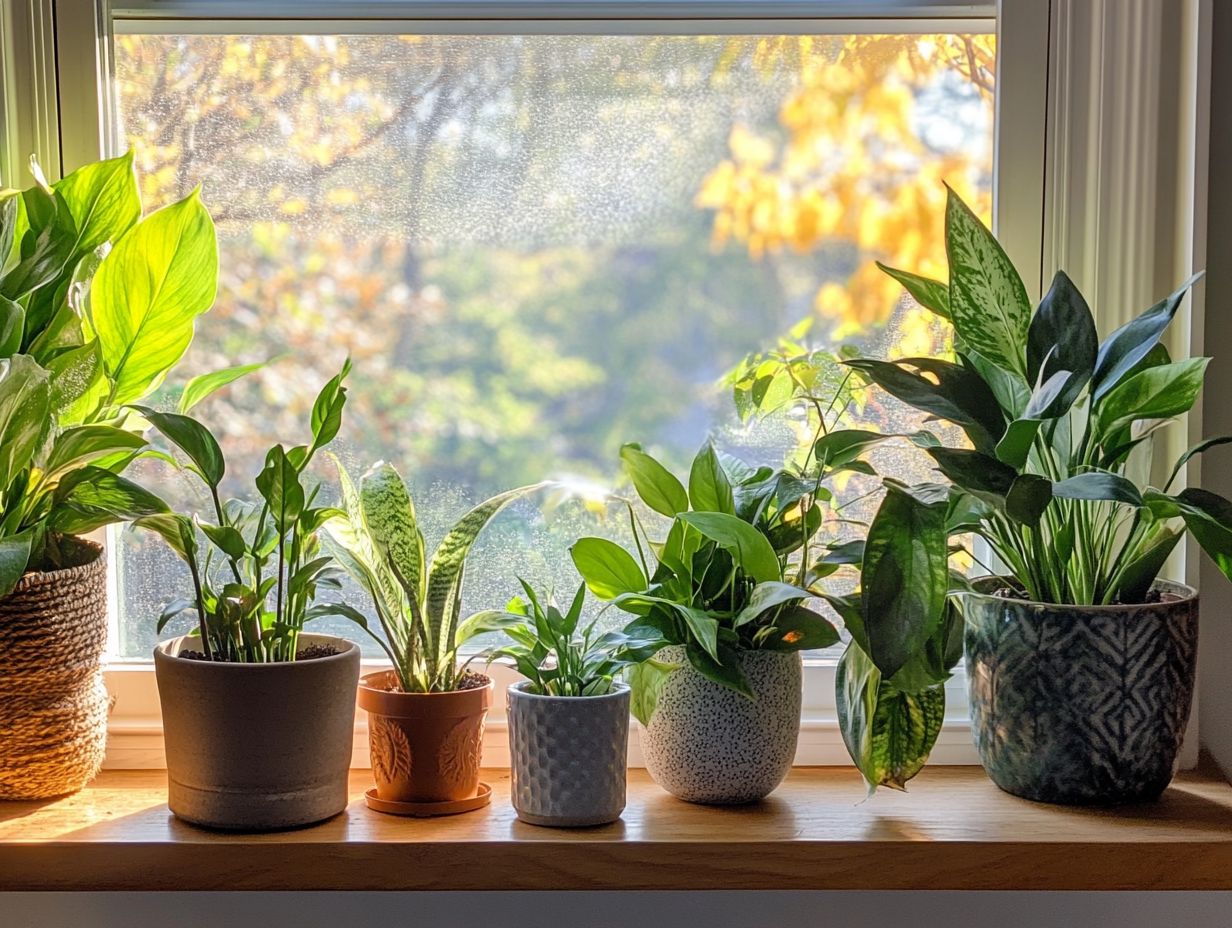
Dieffenbachia, often referred to as Dumb Cane (a common name), is a delightful tropical plant that thrives in low to indirect light. This makes it a favored choice for discerning plant enthusiasts like yourself, who seek an air-purifying option that also brings a splash of vibrant foliage into your home.
To nurture its growth effectively, it’s vital for you to maintain a consistent watering schedule. Allow the top inch of soil to dry out between waterings; this balance is key, as overwatering can lead to root rot.
This resilient species thrives in temperatures ranging from 60 F to 75 F, making it perfectly suited for your indoor environment. Its impressive air-purifying qualities help to reduce toxins, enhancing indoor air quality and fostering a healthier atmosphere throughout your living spaces.
Not only does this plant elevate the visual appeal of your home, but it also contributes positively to your overall well-being and air quality.
Frequently Asked Questions
Got questions about indoor plants? Here are some of the most common queries answered!
What are the best indoor plants for north-facing windows?
Some great options for indoor plants that thrive in north-facing windows include snake plants, pothos, philodendrons, and peace lilies.
Why are north-facing windows a good spot for indoor plants?
North-facing windows receive indirect sunlight, which is perfect for many types of houseplants that prefer low light to moderate light levels.
Do all indoor plants do well in north-facing windows?
No, not all plants will thrive in north-facing windows. Some plants need direct sunlight or bright indirect light. They might not thrive in this position.
Can I place any type of houseplant in a north-facing window?
Consider the lighting and care needs of each plant before placing it in a north-facing window. Some plants may require extra lighting or might do better in a different direction.
Are there any benefits to having indoor plants in north-facing windows?
Absolutely! Indoor plants brighten up your space and boost your mood. They also help purify the air!
Do I need to rotate my plants in north-facing windows to ensure even growth?
Rotate your plants every few weeks! This simple step ensures even growth and keeps them healthy.

